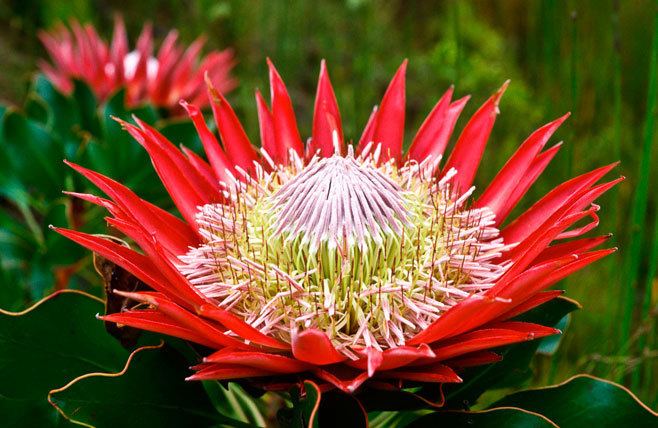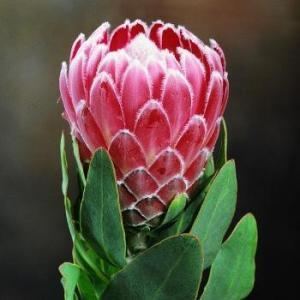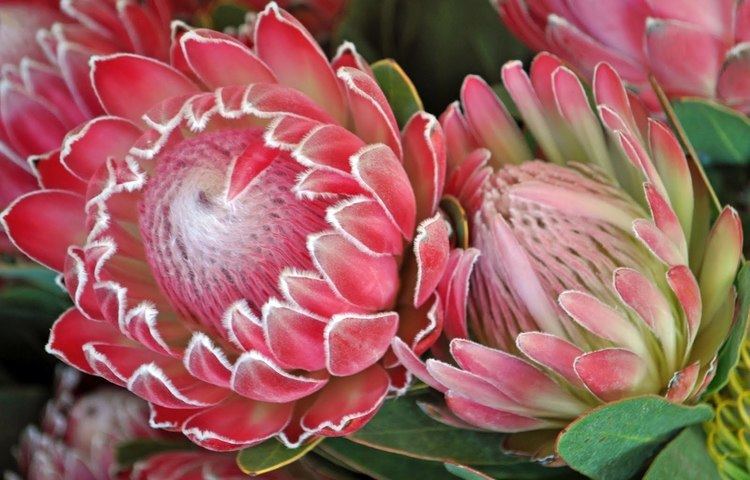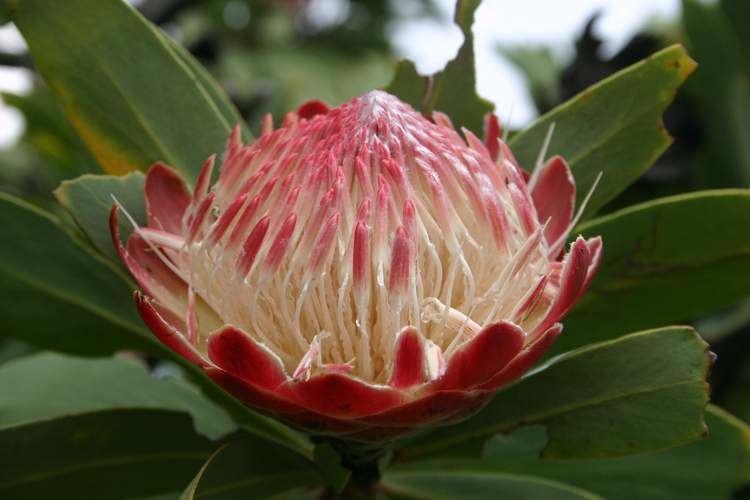Family Proteaceae Scientific name Protea Rank Genus | Order Proteales Higher classification Proteas | |
 | ||
Lower classifications Protea cynaroides, Protea neriifolia, Protea nitida | ||
Express garden tips how to plant proteas 25 03 2014
Protea /ˈproʊtiːə/ is both the botanical name and the English common name of a genus of South African flowering plants, sometimes also called sugarbushes (Afrikaans: suikerbos). In local tradition, the Protea flower represents change and hope.
Contents
- Express garden tips how to plant proteas 25 03 2014
- Protea plant garden update 8 months later protea leucospermum leucadendron and mimetes
- Etymology
- Taxonomy
- Distribution
- Botanical history
- Cultivation
- Classification
- Species
- Hybrids
- References

Protea plant garden update 8 months later protea leucospermum leucadendron and mimetes
Etymology

The genus Protea was named in 1735 by Carl Linnaeus after the Greek god Proteus, who could change his form at will, because they have such a wide variety of forms. Linnaeus's genus was formed by merging a number of genera previously published by Herman Boerhaave, although precisely which of Boerhaave's genera were included in Linnaeus's Protea varied with each of Linnaeus's publications.
Taxonomy

The family Proteaceae to which proteas belong is an ancient one among angiosperms. Evidence from pollen fossils suggest Proteaceae ancestors grew in Gondwana, in the Upper Cretaceous, 75-80 million years ago. The Proteaceae are divided into two subfamilies: the Proteoideae, best represented in southern Africa, and the Grevilleoideae, concentrated in Australia and South America and the other smaller segments of Gondwana that are now part of eastern Asia. Africa shares only one genus with Madagascar, whereas South America and Australia share many common genera — this indicates they separated from Africa before they separated from each other.
Distribution

Most proteas occur south of the Limpopo River. However, Protea kilimanjaro is found in the chaparral zone of Mount Kenya National Park. 92% of the species occurs only in the Cape Floristic Region, a narrow belt of mountainous coastal land from Clanwilliam to Grahamstown, South Africa. The extraordinary richness and diversity of species characteristic of the Cape Flora is thought to be caused in part by the diverse landscape where populations can become isolated from each other and in time develop into separate species.
Botanical history

Proteas attracted the attention of botanists visiting the Cape of Good Hope in the 17th century. Many species were introduced to Europe in the 18th century, enjoying a unique popularity at the time amongst botanists.
Cultivation

Proteas are currently cultivated in over 20 countries. Cultivation is restricted to Mediterranean and sub tropical climates. There are three categories of traits that has to be considered before developing a new cultivar. The yield or production capacity of the cultivar has to be considered. The ease of handling and packaging of the cut stems and the last category is to consider the perceived market value of the cultivar The cultivation of a Protea plant is time consuming and therefore good planning when developing the cross combinations and goals is of great importance of the breeding programme. Some Protea flower species, like the King Protea flower, are self-pollinating flowers. Other Protea species, however, like the Protea Cordata, Protea decurrens and the Protea scabra are self-incompatible and thus rely on cross-pollination for successive seed set. The main vectors responsible for the transfer of pollen in Protea cultivation are birds, insects and wind. There are some Protea species which exhibit both self-pollination as well as cross-pollination as a method of reproduction. Cross-pollination is however preferred as a method of reproduction because it provides genetic diversity in the population. When cultivating Proteas, breeders uses hand pollination as a controlled method to transfer pollen from one flower to another. The following steps are used by breeders to perform hand pollination:
• Cover the inflorescence, which contain only closed flowers, with a plastic bag
• Once the first few flowers have opened, the majority has to be cut back to 10-20 flowers around the receptacle
• After three days the pollen may be applied using a tooth pick. The flower should then again be covered with a plastic bag and marked with a tag containing information regarding the seed, the parent as well as the date of pollination. This step should be repeated until all the flowers are opened and pollinated.
• The seed head should be harvested at nine to twelve months and dried at temperatures more or less at 40 °C to remove the seeds from the receptacle
• The seeds can be germinated in autumn using hot water
• The seeds should then be placed in a sterilized potting medium for germination.
Proteas usually flower during spring time. The general structure of the Protea flower head consists of a mass of flowers on a woody receptacle. The ovary is protected by the receptacle and thus not seen when looking at the flower, the anthers are however present at the top of the flower which can the easily transfer the pollen to the vectors. The common Protea plants, e.g. Protea, Leucospermum and Leucadendron are diploid organisms and thus they can freely hybridise with closely related species of Protea flowers to form a new cultivars. Not all the genera within the family Proteaceae are able to hybridise freely, for example the Leucadendron mentioned previously, cannot be crossed with the Leucospermum because of the difference they display in a haploid chromosome number. Leucodendron]] has a haploid chromosome number of 13 instead of 12 as in the case of Leucospermum. Proteas are used for ornamental practices as cut flowers and for decoration and thus some of the desirable traits a breeder is looking for during cultivation are flower size and colour etc. traits considered by breeders in the selection process for cultivation are long lasting bloom, flowering time, plant architecture, general appearance and adaptability. There are four main methods of selecting Protea flowers for further cultivation: Mass selection, Single plant clonal selection, Chance interspecific hybrid selection, Controlled-pollination interspecific hybrid selection. The four main methods for cultivating Protea plants are sexual reproduction (cultivation with seed). When Proteas are cultivated using seeds, the first step in the cultivation process is to disinfect the seeds by soaking in water maintained at 50 °C for 30 minutes. The germination of the seeds will occur over a period of 14 to 28 days. The germinating seeds should be planted in a medium in pots before the developing roots are 10mm long. Another method for cultivation is vegetative propagation (cultivation with cuttings), which is used to obtain a large protea population of the same genotype. This cultivation method allows for the cultivation of hybrid protea plants without the loss of their unique characteristics. The other two cultivation methods include grafting and budding and micropropagation, referring to cultivation with tissue culture.
Classification
Within the huge family Proteaceae, they are a member of the subfamily Proteoideae, which has Southern African and Australian members.
Species
(listed by section: a sect. has a name in two parts, consisting of the genus name and an epithet).
Hybrids
A hybrid is defined as an offspring between two plants of different species or varieties. Inter- or intraspecific hybridization is used in the cultivation of flowers to improve the qualities including bract colour, flowering time and disease resistance. Intraspecific hybridization refers to a hybrid between different genotypes of the same species whereas interspecific hybridization refers to the progeny between two different species of the same genus. Hybrid flowers are more adaptable to different environments than the pure species, this is why the cultivation of hybrids are preferred. Hybridization of Protea flowers is common amongst the Leucadendron genus to produce unique set of characteristics to meet the market requirements and thus increases market exports and changes the market trend. It is often difficult to identify hybrids from a population based on morphological features, because of the resemblance the species show towards the parent plants. For this reason molecular markers such as RAPD, AFLP, or microsatellite markers and PCR-RFLP are useful in identifying hybrid plants. Another common hybrid is the Protea emixia which is cultivated to flower during the spring and summer months and thus provides cut flowers for export to the Northern Hemisphere. The hybridization of Proteas is usually started by covering the inflorescence of the female plant with a plastic bag to exclude external sources of pollination. After two days the unopened flowers are removed from the inflorescence leaving approximately 40 to 60 opened flowers. The pollen is then hand applied using a brush and the inflorescence is covered again.
